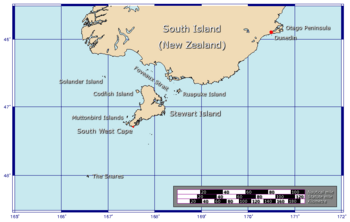Solander Islands facts for kids
|
Māori: Hautere
|
|
|---|---|

Overview map
|
|
| Geography | |
| Location | Southland District |
| Area | 120 ha (300 acres) |
| Highest elevation | 330 m (1,080 ft) |
| Administration | |
The Solander Islands are a group of three small, empty islands in New Zealand. They are officially called Solander Islands/Hautere. These islands are actually old volcanoes that are no longer active. They are located at the western end of the Foveaux Strait, just off New Zealand's South Island.
The Māori name for the islands is Hautere. This name means "flying wind" in English. The islands are about 38 kilometers (24 miles) south of Prices Point. They are also about 64 kilometers (40 miles) northwest of Stewart Island. The total area of the islands is around 1.2 square kilometers (0.46 square miles).
Contents
Exploring the Solander Islands
The Solander Islands are made up of three main parts. Each one has its own unique features.
Solander Island: The Main Landmass
Solander Island is the largest of the three islands. It covers about 1 square kilometer (0.39 square miles). This island rises steeply to a peak that is 330 meters (1,083 feet) above sea level. Most of the island is covered in trees. However, its northeast end is mostly bare, white rock. There is also a deep cave on the east side, known as Sealers Cave.
Little Solander Island: A Smaller Peak
Little Solander Island is located about 1.9 kilometers (1.2 miles) to the west. It is also very steep and reaches a height of 148 meters (486 feet). This island is much smaller, covering only about 4 hectares (9.9 acres). It looks quite barren and is covered in guano, which is bird droppings.
Pierced Rock: A Tiny Outcrop
Pierced Rock is the smallest of the three. It is about 250 meters (820 feet) south of the main Solander Island. This rock rises to 54 meters (177 feet) high. It is very small, covering only about 2,000 square meters (0.49 acres).
A Look Back: History of the Islands
The Solander Islands have an interesting history, especially because of their remote location.
First Sightings and Names
The islands were first seen by Captain James Cook on March 11, 1770. He named them after Daniel Solander, a Swedish scientist. Daniel Solander was part of the scientific team on Cook's ship, the Endeavour.
Early Visitors and Challenges
It is very hard for ships to get close to the Solander Islands. This is because of the rough seas and bad weather. Because of this, the islands have only been lived on for short times. This usually happened when people were shipwrecked or stranded there.
Between 1808 and 1813, five men lived on the islands. Four were European, and one was an Australian Aboriginal. They were likely left there to hunt seals. However, the rough ocean made it impossible for a ship to pick them up. In 1810, seal hunting moved to another island, Macquarie Island. This meant the men were left behind. When they were found in 1813, they had probably collected many dried seal skins.
How the Islands Were Formed: Geology
The Solander Islands are special because of their geological past.
Volcanic Origins
The islands are what is left of an old, extinct Pleistocene volcano. This volcano was active about one to two million years ago. The rocks on the islands are made of a type of rock called andesite. The islands sit on a shallow underwater bank. This bank is less than 100 meters (328 feet) deep.
Unique Volcanic Activity
The Solander Islands are the only volcanic land in New Zealand that formed because the Australian Plate is sliding under the Pacific Plate. This makes them a unique place to study how Earth's plates move.
Plants and Animals: Flora and Fauna
The Solander Islands are home to many different kinds of plants and animals.
Plant Life on the Islands
There are 53 different types of plants with veins (vascular plants) found here. About one-third of these plants are very rare. The plant life is mostly made up of ferns and orchids.
Animal Inhabitants
The southern type of Buller's albatross (Thalassarche b. bulleri) only breeds on the Solander Islands and the Snares Islands. Historically, the Solander Islands were also a well-known area for migrating whales. This included southern right whales and sperm whales. It was said that the sperm whales in this area were unusually large.
Bird Life: An Important Breeding Ground
The Solander Islands are very important for many types of birds.
A Special Bird Area
BirdLife International has named the Solander group an Important Bird Area (IBA). This is because it is a vital breeding spot for two specific bird species. About 5,000 pairs of Buller's albatrosses nest here. It is also a key breeding site for common diving petrels.


